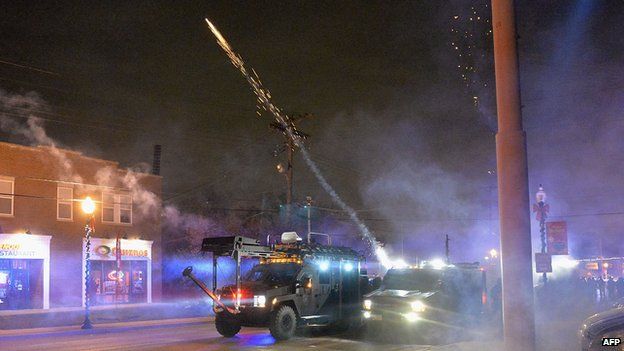Ferguson decision: The facts on tear gas and its use on civilians
- Published

Tear gas has been used in many countries in 2014 and most recently in Ferguson in America to control people protesting over Michael Brown's shooting.
But it's classed as a chemical weapon internationally and is banned for use in war.
For this reason critics have questioned its use on the streets and say it can be lethal.
Police see it as safer than using force and live rounds.
What is tear gas?
It's not actually a gas. It's a liquid at room temperature and is mixed with other substances to form an aerosol.
When it's fired, solid particles are dispersed into the air with the appearance of a smoke cloud.
It works by irritating the mucous membranes in the eyes, nose, mouth and lungs - basically, the bits of your body that are responsible for absorption and secretion.
There are many different types of tear gas. The most common form is CS gas or to use its full name, o-chlorobenzylidene malononitrile. The CS is taken from the initials of the inventors Corson and Staughton.
It is usually fired in a canister to disperse crowds and large gatherings of people, perceived as a threat.
What does it do to you?
Typical symptoms begin about 30 seconds after exposure.
You can get a watery, burning sensation in the eyes, breathing difficulties, chest pain, skin irritation and temporary blindness.
Professor Alastair Hay, who studies the impact of chemical weapons at the University of Leeds, says that while it is considered a safer option, deaths can sometimes occur. This is often as a result of people being restrained by police where breathing is restricted or when they are subsequently unable to breathe fresh air.
Physical exertions such as running and repeated exposure to tear gas can make the symptoms worse.
The effects can be even more damaging if a person has asthma or other respiratory issues already.
People have also been known to be injured by the metal canisters used to fire the gas into a crowd.
How are the symptoms relieved?
The most commonly used remedy is pouring milk over the face.
The symptoms usually disappear by themselves after about 30 minutes. Fresh air and steady breathing help reduce the impact of the gas.
Blowing your nose, coughing and spitting are also thought to help.
Rubbing your eyes can make the symptoms much worse.
The chemicals will stay on skin and in clothes, so taking a lukewarm shower and washing the clothes will help prevent any long-term effects.
Who can use it?
It is prohibited to use any form of tear gas in war under the Chemical Weapons Convention as it is classified as a chemical weapon. However law enforcement teams around the world use it on civilians.
Police in the UK are regularly trained in the use of CS spray. They are told they can deploy it only "when they feel that the offender poses a risk to themselves and/or the police officers and others in the vicinity."
It is illegal to buy or possess CS gas in the UK, but it is available as a form of self-defence in many other countries including the United States and some European nations.
Being in possession of it in the UK is punishable with a minimum of six months in jail to a maximum of 10 years.
You can, however, buy "deterrent" sprays which look like CS gas but contain other chemicals such as smart water (a non-hazardous liquid with a long lasting "fingerprint") or a smelling agent which stays on a person's skin, allowing them to be easily identified.
Can protesters protect themselves?
Protest groups and websites offer advice on the best ways to avoid the symptoms of tear gas.
They say gas masks are the best prevention, swimming goggles and cycling masks are a substitute.
Protesters sometimes use bandanas soaked in vinegar and water which are tied tightly around the face as a last resort. This also helps to prevent people being recognised.
Wearing contact lenses may trap the chemicals and cause more irritation to the eyes.
Anything else?
Tear gas was widely used in the trenches of World War One along with mustard gas and other more deadly gasses.
A total of 87 countries signed the Chemical Weapons Convention in 1997 which banned the use of any chemical weapons in warfare.
The Foreign Office said it was looking at whether it needed to block the export of tear gas to other countries after Hong Kong's authorities used it on pro-democracy protesters as recently as September.
French police recently used CS gas on Everton supporters who clashed with rival supporters ahead of their Europa League tie.
Follow @BBCNewsbeat on Twitter and Radio1Newsbeat on YouTube